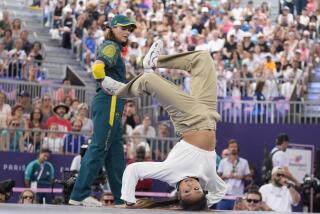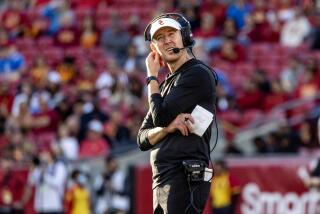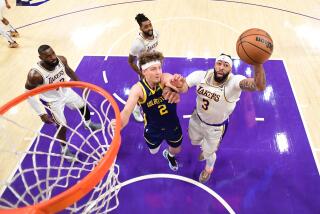Glenn Davis, 80; College Football Star
Glenn Davis, the Heisman Trophy-winning “Mr. Outside” on Army’s national championship football teams of the mid-1940s, died Wednesday, his son Ralph told The Times. Davis was 80.
Davis, generally recognized as one of the finest all-around athletes ever to come out of Southern California, died of complications from prostate cancer at his home in La Quinta, Calif.
A 5-foot-9, 170-pound halfback, Davis teamed with fullback Felix “Doc” Blanchard, “Mr. Inside,” when the U.S. Military Academy dominated college football during and just after World War II. Army, going undefeated, won national titles in 1944 and ‘45, then finished a close second to Notre Dame after those teams had played to a 0-0 tie at Yankee Stadium in 1946.
Davis and Blanchard, also widely known as “the Touchdown Twins,” remain to this day college football’s most famous running-back combination.
Davis was the speed merchant around end, Mr. Outside, and Blanchard the batterer between tackles, Mr. Inside. They were honored as recently as a year ago, co-winners of the Doak Walker Legends Award at Southern Methodist University in Dallas. Blanchard remains the oldest living Heisman winner.
They were All-Americans all three seasons they played together and each won the Heisman Trophy as college football’s outstanding player, Blanchard in 1945 and Davis in 1946, when Davis also was voted Associated Press male athlete of the year, the first football player to be so honored. Davis’ career average of 8.3 yards a carry remains the major-college record. In 1945, he carried the ball only 82 times but gained 944 yards, an 11.5-yard average.
Davis, whose speed made him the perfect complement to the bigger, hard-running Blanchard, finished with 2,957 yards, Blanchard with 1,908 as Army posted a 27-0-1 record during their time as teammates. Davis scored 59 touchdowns, Blanchard 38.
They did more than just run with the ball, however. Both blocked, and both, as was customary then, played on defense as well as offense, Davis as a defensive back, Blanchard as a linebacker. In his final game for Army -- against Navy -- Davis made a leaping, left-handed interception and returned it for a touchdown.
Blanchard also was a good pass receiver, which worked out well, since Davis was a good passer. Blanchard caught eight touchdown passes at Army, five of them thrown by Davis.
A teammate, Bill Yeoman, former coach at the University of Houston, told The Times in 1983: “There are words to describe how good an athlete Doc Blanchard was. But there aren’t words to describe how good Davis was.”
Time magazine wrote in 1945: “Davis ... carries a special kind of speed that is all his own. After a brief show of hippiness, enough to get around the end, he simply leans forward and sprouts wings.”
Davis’ Army coach, the legendary Earl “Red” Blaik, once declared, “Glenn Davis could do anything you asked, and he did it better than almost anyone else.... He’s the best halfback I’ve ever seen.”
He was the best athlete many ever saw.
Davis was born in Claremont the day after Christmas in 1924, the son of Ralph and Ima Davis. After a standout prep career at Bonita High in La Verne, where he earned 13 letters in four sports, he went to West Point along with his twin brother, Ralph, Glenn’s high school teammate who played junior varsity football for Army. Ralph, of Joshua Tree, died in January.
In 3 1/2 years at West Point, Davis won 10 letters, four in football, three in baseball, two in track and one in basketball. In 51 baseball games for Army, he batted .403, stole 64 bases in 65 attempts, including second, third and home in an exhibition against the Brooklyn Dodgers. Branch Rickey, then-Dodger president who had already signed Jackie Robinson, another of Southern California’s elite all-around athletes, offered Davis $75,000 to sign, heavy-duty money in the ‘40s.
With his speed, track probably would have been Davis’ best sport, had he concentrated on it. In 1947, he ran a 6.1-second 60-yard dash at Madison Square Garden, beating Barney Ewell, who the next year won the silver medal in the 100 meters at the London Olympics.
The track story everyone likes to tell about Davis, though, occurred later that spring, on the same day Davis had already played nine innings of baseball in center field, getting, as he later recalled, “a couple of hits.” After that game, although he had not run an outdoor meet that season, he rushed to the track because Army was short of sprinters. In borrowed shoes, he won the 100-yard dash in 9.7 seconds, then later won the 220 in academy-record time, 20.9.
As good an athlete as he was, however, Davis was no whiz as a student. He graduated 305th in a class of 310, and mathematics nearly did him in during his first term at the Point. It was 1943, the war was raging, and officers were in critical demand, so at the academy, courses were accelerated. Cadets were expected to do four years’ work in two or three -- and athletes caught no breaks. Davis, who that season rushed for 1,028 yards, took to getting up at 4 a.m. to have 90 minutes of study time before reveille, but he still flunked his math course.
“I just couldn’t do it all,” he told Sports Illustrated in 1988. “I was taking five classes every day. I’d get out of the last one at 3:30 and be on the football field at 4. I wouldn’t get home until 6:30, then I’d have dinner and study.”
So in December, he was sent home, with instructions to study hard, make up his deficiencies and apply for reappointment in 1944.
He did all that and when he returned, Blanchard was arriving as a plebe -- a freshman -- and the sports world was about to experience thunder and lightning in human form.
After their three glorious seasons together, the war fading into memory, Army’s dazzling duo was in high demand. Davis was drafted by the Detroit Lions of the National Football League, Blanchard by the Pittsburgh Steelers. The San Francisco 49ers of the upstart All-America Football Conference acquired that league’s rights to both, however, and offered them $130,000 each, $10,000 in signing bonuses and $40,000 a year for three seasons. At the time, pro football’s best players were making about $20,000.
Problem was, both were newly commissioned second lieutenants with three-year military obligations.
They appealed to West Point’s superintendent, Maj. Gen. Maxwell Taylor, for a two-month extension of their 60-day postgraduate furlough, hoping to play the ’47 season with the 49ers. They also asked for four-month leaves in each of the next four years, in return promising 20-year military commitments.
Taylor agreed, but terms of the deal were leaked and irate congressmen and indignant columnists, charging special treatment, prompted him to renege. Both Davis and Blanchard prepared to report for active duty.
First, though, there were the duly authorized furloughs and a chance for some seemingly easy money. Hollywood had come calling, offering $20,000 apiece for Davis and Blanchard to star in a movie, “The Spirit of West Point.”
It was easy money for Blanchard. It was traumatic for Davis. Filming a football scene at UCLA, he cut, as he had cut hundreds of times before, twisted his right knee and collapsed with what he later said were torn ligaments.
“It was the end of me,” he said.
Davis eventually had the reconstructive surgery available at the time, but the knee didn’t heal right and was wobbly ever after.
Still, he was deemed fit enough to fulfill his military commitment and was assigned to the infantry. Blanchard was assigned to the Air Force, then beginning as a separate branch. He became a jet pilot and served until 1971, retiring as a colonel.
On furlough in 1948, Davis met a young starlet, Elizabeth Taylor, and a highly publicized romance blossomed. The next year, when Davis returned from Korea for his annual leave, he was met by Taylor at the Miami airport, a reunion covered by Life magazine, which ran a photo of Taylor wiping lipstick from “the handsome lieutenant’s” face.
Davis, however, did not become the first of Taylor’s many husbands, although he later was married, briefly, to another actress, Terry Moore.
After fulfilling his military commitment, only two months before the Korean War broke out, Davis, hoping to resume his football career, resigned his commission.
By then, what was left of the All-America Conference had merged with the NFL and the Los Angeles Rams had acquired the rights to Davis.
He played with them for two seasons, taping and bracing his shaky knee, but he was never the running back he had been at West Point.
Still, his pro career was hardly a bust. In 1950, the Rams advanced to the championship game -- they lost it to the Cleveland Browns, one of those AAFC transplants -- and Davis led the team in rushing, gaining 416 yards, averaging 4.7 a carry. He also caught 42 passes for 592 yards -- for a team that boasted eventual Hall of Fame receivers Tom Fears and Elroy “Crazylegs” Hirsch.
Injuries nagged Davis in 1951 and he rushed only 64 times for 200 yards, then sat out the ’52 season. He hoped to come back in 1953, but his knee wouldn’t let him make the cuts a running back has to make and his football career ended in an exhibition game against the Philadelphia Eagles at Little Rock, Ark., in early September of that year.
Davis took a job with The Times in 1954 as assistant director of special events, then moved up to director in 1960, spearheading the paper’s many charity sporting events until his retirement in 1987.
After his marriage to Moore, he married Harriett Lancaster Slack in 1953 and, after her death in 1995, married Yvonne Ameche, widow of 1954 Heisman winner and NFL great Alan Ameche, in 1996.
Davis gave his Heisman Trophy to Bonita High School several years ago. The athletic field at the school is named after Davis, and each year The Times gives the Glenn Davis Award to the top high school football player in Southern California.
In addition to his son Ralph of Van Nuys, survivors include his wife, Yvonne, of La Quinta, and stepson John Slack III of Baton Rouge, La.; a sister, Mary Gammons of Pomona, and several grandchildren.
Funeral arrangements are pending.
More to Read
Go beyond the scoreboard
Get the latest on L.A.'s teams in the daily Sports Report newsletter.
You may occasionally receive promotional content from the Los Angeles Times.










